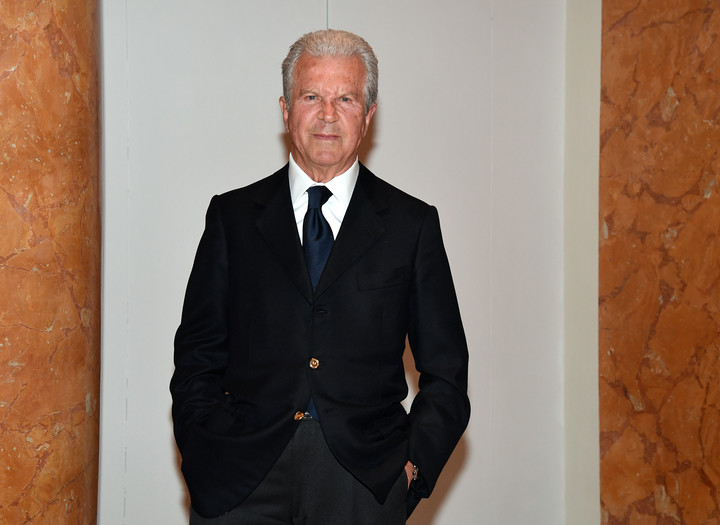

For five days, the Pantheon is “moving” to Sanremo. This year, for the 73rd Sanremo Music Festival, the innovative set design will feature a spectacular dome. Unlike the dome of the famous Pantheon, at Sanremo, it will be a riot of colored lights. We were given a preview by the presenter, Amadeus, with a live tour on Fiorello's show, 'Viva Rai2!' but it was only a taste of the excitement to come when the curtain rises.
We talked to Gaetano Castelli, an internationally renowned set designer, who has been behind the designs for Sanremo since 1987, over the past nine years alongside his daughter Maria Chiara. “That video doesn't do it justice. I'm at my twenty-first Festival, and I think I can say that this is one of the most impressive creations ever seen at the Ariston. To the extent that the mayor of Sanremo, as soon as he entered the Ariston [TN: theater], though judging it amazing, was worried that I had removed some seats from the audience. Actually, it’s quite the opposite: this year there are 28 places more.”
What inspired you and your daughter to create this new work?
“I wanted to create a set that could thrill and excite the audience, who are all looking forward to a good time, albeit brief. To tell you the truth, it was Amadeus who came up with the idea of the dome and he told me and the director Stefano Vicario almost a year ago, as soon as he agreed to present the festival again. We immediately got to work: the entire set design reaches a maximum height of 14 meters, with a length of 20 meters. The dome has projecting bands of lights: each line is connected to a computer and can break down into different light designs, coordinating with the rhythm of the music. Let's take the song by Madame, for example, which is very upbeat. It cannot be accompanied by light, still colors; scenography and music must become one. The result is a continuously changing kaleidoscope of images.”
What other new elements should we look out for?
“The entrance to the Ariston will be majestic. I invented ribbons that contain LED lights that start from the walls of the theater and reach up to the ceiling, surrounding the orchestra. This will create a sort of tunnel effect before reaching the curtain, which will rise to reveal the dome. I also banned the color black, which is now everywhere in television, making them look like nightclubs. It's not suitable for an evening that’s supposed to be fun and entertainment.”
You have lots of experience, you have traveled a lot: how has set design changed?
I'm used to the great variety shows of the golden age of Italian television, I worked with legends like Antonello Falqui. We need to make people understand the importance of traditional scenography as a support to the increasingly sophisticated technology we have today. I was talking about it just a few days ago with Dante Ferretti, who studied with me at the Academy of Fine Arts. It is important to preserve the craftsmanship and creativity of this profession, and therefore keep the workshops and tailors alive, precisely today that technology is taking over. Abroad, Italian scenography is sought after because they appreciate our artistic sensitivity, the fact that we know how to create sculptural scenes. If our craftsmen were no longer able to do this, a wealth of knowledge would be lost.”
You are a painter, how much and how does the art component count in this work?
“A set designer must be a painter, sculptor and architect: if I didn't know how to paint, how would I do the sketches? The truth is that I started out as a painter, and I brought my painting into scenography, not vice versa. I studied at the liceo artistico [TN: art high school], I taught painting, and when I was young, I took part in the exhibitions organized for the Rome Quadrenniale.”
You consider Sanremo your home. You must have a thousand stories to tell: do you want to share one with me?
“At my first Festival, in 1987, the artists were still lip-syncing. It was Pippo Baudo who later brought in the orchestra and allowed live performances. I remember that in one edition, Pippo asked to have the orchestra behind him. Space was very limited; I didn't know where to put the 84 orchestra musicians and their instruments. So I had to build three floors to fit them all in. When Fiorello arrived, he immediately asked where the underwear department was. Jokingly, he explained that it was like being in the Rinascente [TN: department store].”
What are your plans for the future?
I travel a lot. At the moment, I'm working on an interesting project in Paris: I have to redo a theater that is located above the Moulin Rouge, called the Mistenguett. I'm going to turn it into the new Moulin Rouge (which needs an extension because it’s full every night). I’m going to London soon, to the Piccadilly Theater, to see the musical on the history of the famous Théâtre Pigalle. This job requires enthusiasm and continuous professional updating; experience is not enough. I am fortunate to have a team of excellent colleagues beside me; my right-hand man is Manuel Bellucci, who takes care of the computer, animation and 3D stuff.”
What happens to the set of each Sanremo festival when it all ends?
“By contract with RAI, the supplier companies must dismantle everything and throw it away. Nothing is kept, because it would require huge sheds.”
Could things be different this year?
“Amadeus said he doesn’t want to dismantle the dome but to keep it for next year. That’s all talk, so we’ll see.”